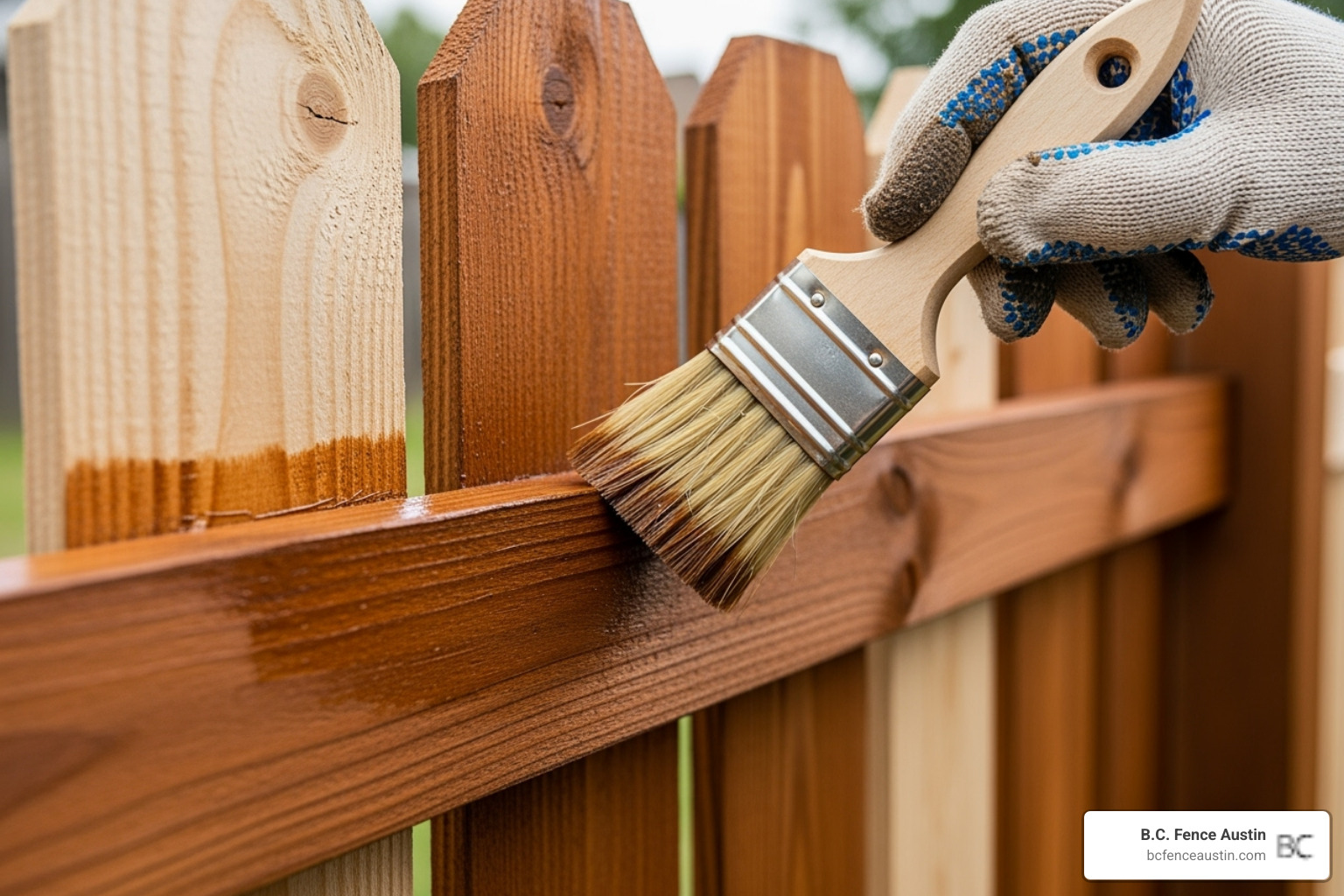Why Staining Your Wood Fence Matters

Stain wood fence projects are one of the most impactful DIY tasks you can tackle to protect your investment and boost your home’s curb appeal. If you’re wondering whether staining is worth the effort, here’s what you need to know:
Quick Answer: How to Stain a Wood Fence
- Clean – Power wash and let dry 24-48 hours
- Repair – Fix loose boards and fill gaps
- Sand – Smooth rough areas with medium-grit sandpaper
- Apply – Use sprayer, brush, or roller working top to bottom
- Maintain – Re-stain every 2-3 years
Most homeowners choose wooden fences for their natural beauty and versatility, but wood is vulnerable to moisture, UV rays, and rot without proper protection. Whether your fence is brand new or hasn’t been treated in years, staining creates a protective barrier that extends its lifespan while enhancing the wood’s natural grain.
The good news? Staining a fence is surprisingly manageable for DIYers. With the right products and preparation, you can achieve professional-looking results in a weekend. Unlike paint, which sits on the surface and can peel or chip, stain penetrates the wood fibers to provide lasting protection without hiding the texture you paid for.
This guide walks you through every step—from choosing between water-based and oil-based stains to fixing common mistakes like drips and uneven coverage. You’ll learn how to prep your fence properly, select the right tools, and apply stain like a pro.

Why Stain Your Wood Fence? Benefits and Stain Selection
A beautiful wooden fence adds character and charm to any property, but looks aren’t everything. If you’re considering a stain wood fence project, you’re making a smart choice that goes far beyond aesthetics.
Here’s the thing about staining versus painting: while paint sits on top of the wood like a thick blanket, covering everything underneath, stain actually soaks into the wood fibers. Think of it like moisturizer for your skin versus wearing a mask. Stain improves what’s already there, letting the natural grain and texture shine through while providing essential protection. It’s the difference between hiding your fence and highlighting its best features.
The protective benefits of staining run deep—literally:
UV protection is one of the biggest advantages. Just like your skin can burn and age from sun exposure, wood suffers similar damage from UV rays. Unprotected wood fades to an unattractive gray and becomes brittle over time. Quality stains create a UV-resistant coating that shields your fence from harsh sunlight, potentially extending its lifespan by two to three times.
Moisture barriers are equally critical. Wood naturally absorbs water, which leads to swelling, warping, cracking, and eventually rot. Stain repels moisture like a raincoat, preventing water from seeping in and causing damage. This protection also discourages mold and mildew growth, which can weaken the wood structure and create health concerns.
Rot and pest prevention go hand in hand with moisture control. When water can’t penetrate the wood, fungal decay can’t take hold. Many modern stains also include properties that make your fence less appealing to wood-destroying pests like termites and carpenter ants looking for their next home.
Improved appearance might seem obvious, but it’s worth mentioning. A fresh coat of stain revitalizes tired, weathered wood, bringing back vibrant color and making your fence look well-maintained. This directly boosts your home’s curb appeal and property value—something potential buyers definitely notice.
When you choose to stain wood fence rather than leave it untreated, you’re investing in both beauty and longevity. For a deeper dive into your options, check out our guide on Should I Paint or Stain My Wood Fence?.
Choosing the Right Type of Wood Fence Stain
Selecting the perfect stain involves more than just picking a color you like. You’re choosing a formula that needs to work with your specific wood type, climate, and desired look.

Understanding Stain Bases
The foundation of every stain is either water-based or oil-based, and each has distinct characteristics:
Water-based stains are the go-to choice for many DIYers. They clean up easily with soap and water, dry faster (usually within a few hours), and have lower VOCs, which means less odor and fewer harmful fumes. They work well on most wood types and won’t yellow over time. The downside? They can raise the wood grain slightly, requiring light sanding between coats.
Oil-based stains penetrate deeper into the wood and are particularly well-suited for naturally oily woods like cedar and redwood. These tannin-rich woods can sometimes “bleed” through water-based products, causing discoloration. Oil-based formulas create a rich, durable finish that really brings out the wood’s character. They do take longer to dry (often 24-48 hours between coats) and require mineral spirits for cleanup, but many professionals prefer them for their superior penetration and longevity.
Choosing Your Opacity Level
Stain opacity determines how much of your wood’s natural grain and color remains visible. This is where your personal taste and your fence’s current condition come into play:
Transparent stains use ultra-fine pigments that improve rather than hide the wood grain. They’re perfect for showcasing beautiful new cedar, redwood, or cypress fences where you want the natural beauty to take center stage. While they provide excellent UV protection, they add minimal color and require more frequent reapplication—typically every 1-2 years.
Semi-transparent stains offer a sweet spot between protection and natural appearance. They add noticeable color while still letting the wood grain show through clearly. This option works great when you want to enrich your fence’s tone without masking its character. Expect to re-stain every 2-3 years.
Semi-solid stains provide more pigment and coverage, giving you a more uniform appearance while still allowing some texture to show. They’re ideal for fences with minor imperfections you’d like to downplay, offering good protection that typically lasts 3-4 years.
Solid stains deliver maximum color and coverage, completely hiding the wood grain while showing only the texture. If your fence has weathered badly or has significant imperfections, solid stain can give it a fresh, uniform look similar to paint—but with better penetration and flexibility. These can last 4-5 years before needing touch-ups.
Matching Stain to Wood Type
Different wood species have unique characteristics that affect how they accept and display stain:
Cedar and redwood are premium fencing materials naturally resistant to rot and insects. Their rich tannin content means they can bleed through some water-based stains, so oil-based formulas or specially designed water-based products work best. These woods have gorgeous natural colors that transparent or semi-transparent stains beautifully improve. To learn more about these durable options, read our Cedar vs. Redwood Fence guide.
Pine and treated lumber are softer woods that readily absorb stain—sometimes too readily. Pressure-treated pine needs to dry out for several months after installation before staining, or the moisture trapped inside will prevent proper adhesion. These woods often benefit from semi-transparent or solid stains that add both color and substantial protection to the naturally pale wood.
Stain vs. Paint for Fences
When deciding whether to stain wood fence or paint it, understanding the fundamental differences helps you make the right choice for your specific situation.
Here’s how they stack up:
| Feature | Wood Stain | Paint |
|---|---|---|
| Durability | Penetrates wood fibers; lasts 2-5 years depending on opacity; requires reapplication more frequently | Forms surface film; lasts 3-7 years; provides harder protective layer |
| Appearance | Improves natural wood grain and texture; available in transparent to solid opacities; creates natural, organic look | Completely covers wood grain; provides uniform, opaque finish; more color options available |
| Application | Easier to apply; forgiving of mistakes; less prep work needed; can apply over existing stain | Requires thorough prep and priming; more technique-sensitive; difficult to apply over stain |
| Maintenance | Easy touch-ups; fades gradually; simply clean and reapply | Chips and peels over time; requires scraping and sanding before repainting; more labor-intensive maintenance |
The key difference comes down to penetration versus coating. Stain soaks into the wood, becoming part of it and moving with it as it expands and contracts with weather changes. Paint creates a protective film on top of the wood, which offers excellent protection but can crack or peel when the wood beneath it shifts.
Maintenance frequency varies significantly. Stain typically needs reapplication every 2-3 years for semi-transparent varieties, while solid stains can last 4-5 years. Paint might last longer initially, but when it does fail, it fails dramatically—think peeling and chipping that requires extensive prep work to fix.
The beauty of stain is that when it fades, it does so gradually and evenly. You simply clean the surface and apply a fresh coat. No scraping, no peeling to deal with. Paint, on the other hand, often requires you to scrape off loose material, sand rough spots, prime bare wood, and then repaint—a much more involved process.
For most homeowners who value the natural beauty of wood and want a lower-maintenance option, staining is the clear winner. But if you’re looking to completely change your fence’s color or need to cover up significant damage, paint might be your better bet.
